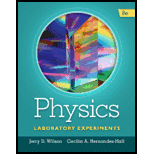
Physics Laboratory Experiments
8th Edition
ISBN: 9781285738567
Author: Jerry D. Wilson, Cecilia A. Hernández-Hall
Publisher: Cengage Learning
expand_more
expand_more
format_list_bulleted
Textbook Question
Chapter 27, Problem 4Q
- (a) Circular metal wires in electrical circuits may have different cross-sectional areas (different diameters) and different lengths. For a given applied voltage, how would the joule heat vary with these parameters?
- (b) Would the wire material make a difference? (Hint: See resistivity in your textbook.)
Expert Solution & Answer
Want to see the full answer?
Check out a sample textbook solution
Students have asked these similar questions
After the steady state , the temperature of a conductor doesnot rise , even though heat is supplied , Why?
Given the following:
Material:
-copper
Coefficient a (1/°C):
-3.9x10^-3
Material:
Constantan (Cu, Ni, alloy)
Coefficient a(1/°C):
-0.002x10
Suppose you want to double a copper‘s wires resistance. To what temperature, in degrees Celsius, must you raise it if it is originally at 18°C, neglected any changes and dimensions?
What is the useful energy output when a 60 W light bulb is on for 2 hours?Recall, traditional light bulbs are only 5% efficient.
Chapter 27 Solutions
Physics Laboratory Experiments
Ch. 27 - Prob. 1ASACh. 27 - What is the difference between joule heat and...Ch. 27 - Given two different resistances, how does the...Ch. 27 - Prob. 4ASACh. 27 - Prob. 5ASACh. 27 - Prob. 1QCh. 27 - Why was it necessary to make adjustments to...Ch. 27 - Prob. 3QCh. 27 - (a) Circular metal wires in electrical circuits...Ch. 27 - Do heating appliances such as hair dryers and...
Knowledge Booster
Learn more about
Need a deep-dive on the concept behind this application? Look no further. Learn more about this topic, physics and related others by exploring similar questions and additional content below.Similar questions
- Check Your Understanding How much energy does a 1.5-V AAA battery have that can move 100C ?arrow_forwardif the heat capacitance for a Container of Aluminum is 270 J/Co and the specific tempreture of Aluminum is 900 J/kg.Co , find the Container massarrow_forwardWhat percentage of the power is lost in the power lines if the temperature of the wire is 23.3oC?arrow_forward
- A Cu wire of diameter of 2 mm and length of 1 m initially at room temperature of 300 K is applied a constant voltage difference of 100 V for 1000 seconds. The temperature of the wire rose due to Joule heating during the application of the voltage, so one waited for a sufficiently long time after the voltage is removed for the wire to cool back to the room temperature of 300 K. The conductivity of Cu is 6×107S/m. Please answer the following questions, assuming the surroundings is at room temperature 300 K: (a) What is the internal energy change for the wire from the very initial state to the final state after the entire process ends? (b) What is the internal energy change for the surroundings for the entire process? (c) What is the amount of heat that was generated in the wire and transferred to the surroundings during the entire process? (d) What is the total internal energy change of the wire plus the surroundings during the entire process? (e) What is the entropy change for the wire…arrow_forward- If the heater wire is replaced by a wire with lower resistance, is the time required to heat the gas (a) unchanged,(b) increased, or (c) decreased?arrow_forwardWe supply electric current continously to an electric heater. But the temperature of heater remains constant after some time, Why?arrow_forward
- It is proposed to have a water heater that consists of an insulated pipe of 7.5-cm diameter and an electric resistor inside. Cold water at 20°C enters the heating section steadily at a rate of 24 L/min. If water is to be heated to 48°C, determine (a) the power rating of the resistance heater and (b) the average velocity of the water in the pipe.arrow_forwardAt RM 0.218 Kilowatt-hour, how much it cost to leave a 6 W kitchen bulb on day and nightfor a 6 months period?arrow_forwardAn immersion heater is a small appliance used to heat a cup of water for tea by passing current through a resistor. If the voltage applied to the appliance is doubled, will the time required to heat the water change? By how much? Isthis a good idea?arrow_forward
- How much electrical energy (in kilowatt hours) would a 45.0 W light bulb use in 60.0 days if left on steadily?arrow_forwardAn electric water heater is designed to produce 48 kWkW of heat when it is connected to a 240-V source. If the heater is 88 %% efficient, how long would it take to heat 51 galgal of water from 20∘C∘C to 60 ∘∘? Express your answer using two significant figures.arrow_forwardWhen a metal rod is heated, not only its resistance but also its length and cross-sectional area change.The relation R = rL/A suggests that all three factors should be taken into account in measuring r at various temperatures. If the temperature changes by 1.0 C°, what percentage changes in (a) L, (b) A, and (c) R occur for a copper conductor? (d) What conclusion do you draw? The coefficient of linear expansion is 1.70 * 10-5 K-1.arrow_forward
arrow_back_ios
SEE MORE QUESTIONS
arrow_forward_ios
Recommended textbooks for you
 Glencoe Physics: Principles and Problems, Student...PhysicsISBN:9780078807213Author:Paul W. ZitzewitzPublisher:Glencoe/McGraw-Hill
Glencoe Physics: Principles and Problems, Student...PhysicsISBN:9780078807213Author:Paul W. ZitzewitzPublisher:Glencoe/McGraw-Hill

Glencoe Physics: Principles and Problems, Student...
Physics
ISBN:9780078807213
Author:Paul W. Zitzewitz
Publisher:Glencoe/McGraw-Hill

DC Series circuits explained - The basics working principle; Author: The Engineering Mindset;https://www.youtube.com/watch?v=VV6tZ3Aqfuc;License: Standard YouTube License, CC-BY